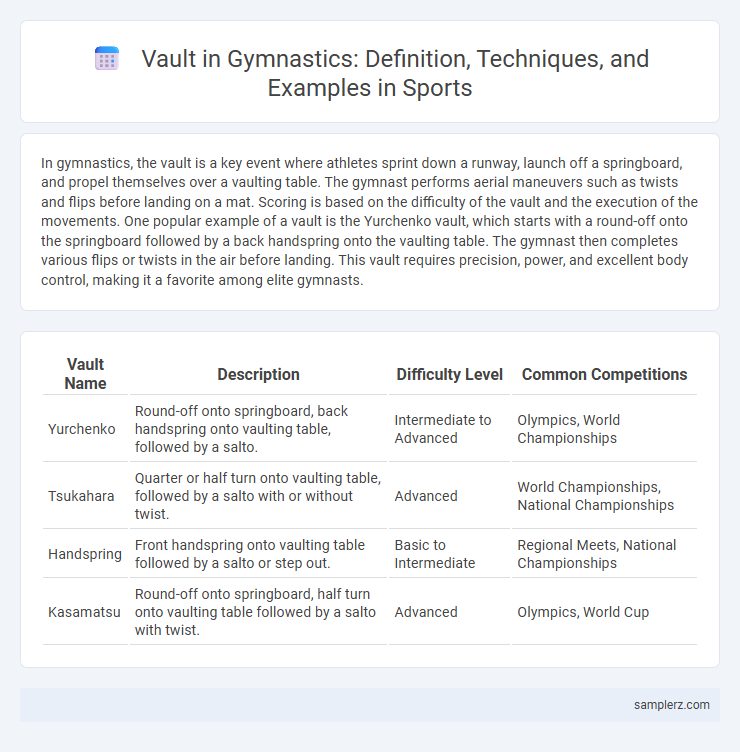In gymnastics, the vault is a key event where athletes sprint down a runway, launch off a springboard, and propel themselves over a vaulting table. The gymnast performs aerial maneuvers such as twists and flips before landing on a mat. Scoring is based on the difficulty of the vault and the execution of the movements. One popular example of a vault is the Yurchenko vault, which starts with a round-off onto the springboard followed by a back handspring onto the vaulting table. The gymnast then completes various flips or twists in the air before landing. This vault requires precision, power, and excellent body control, making it a favorite among elite gymnasts.
Table of Comparison
| Vault Name | Description | Difficulty Level | Common Competitions |
|---|---|---|---|
| Yurchenko | Round-off onto springboard, back handspring onto vaulting table, followed by a salto. | Intermediate to Advanced | Olympics, World Championships |
| Tsukahara | Quarter or half turn onto vaulting table, followed by a salto with or without twist. | Advanced | World Championships, National Championships |
| Handspring | Front handspring onto vaulting table followed by a salto or step out. | Basic to Intermediate | Regional Meets, National Championships |
| Kasamatsu | Round-off onto springboard, half turn onto vaulting table followed by a salto with twist. | Advanced | Olympics, World Cup |
Definition and Importance of Vault in Gymnastics
Vault in gymnastics is a dynamic event involving a sprint, springboard launch, and acrobatic flight over a vaulting table, showcasing power, speed, and coordination. It is essential for developing explosive strength and agility, contributing significantly to an athlete's overall performance and competitive score. Mastery of vault techniques enhances a gymnast's versatility, making it a pivotal component in all-around competitions.
Classic Vault Examples Performed by Elite Gymnasts
Elite gymnasts frequently perform the Yurchenko vault, characterized by a round-off onto the springboard followed by a back handspring onto the vault table, demonstrating exceptional power and precision. The Tsukahara vault, involving a quarter or half turn onto the vault table and a backward salto off, showcases advanced twisting and flipping skills. These classic vaults highlight the combination of speed, strength, and aerial awareness essential at the highest levels of gymnastics competition.
The Yurchenko Vault: Technique and Variations
The Yurchenko vault in gymnastics involves a round-off onto the springboard followed by a back handspring onto the vaulting table, showcasing a complex combination of power and precision. Variations of the Yurchenko include the Yurchenko layout, Yurchenko full twist, and Yurchenko double twist, each demanding advanced aerial control and execution. Mastery of this vault is critical for gymnasts aiming for high difficulty scores in competitive events.
The Handspring Vault: Fundamentals and Execution
The Handspring Vault in gymnastics requires explosive power and precise hand placement to generate momentum and height during the vault. Athletes sprint toward the vaulting table, perform a strong, fast push-off with their hands, and extend their body in a stretched, streamlined position for optimal flight and landing control. Mastery of the handspring vault involves seamless coordination between sprint speed, hand contact, and body alignment to achieve both distance and height.
The Tsukahara Vault: Steps and Key Elements
The Tsukahara Vault involves a powerful round-off onto the springboard followed by a back handspring onto the vaulting table. Key elements include a tight tuck position during the post-flight phase and precise timing for the twisting or flipping somersault off the table. Mastery of the run-up speed, block technique, and body alignment is critical for executing this vault successfully.
Unique Vaults in Olympic History
The Produnova vault, often dubbed the "vault of death," stands out as one of the most unique and challenging in Olympic gymnastics history, involving a front handspring with two twists. Another rare vault is the Yurchenko double pike, first performed by Simone Biles at the Tokyo 2020 Olympics, showcasing unprecedented difficulty and innovation. These vaults exemplify the evolution of gymnastics techniques, pushing the boundaries of athleticism and risk at the Olympic level.
Highest Scoring Vaults in Major Competitions
The Amanar vault, performed by elite gymnasts like Simone Biles, consistently earns some of the highest scores in major competitions due to its difficulty and execution. At the 2016 Rio Olympics, Elsabeth Black achieved a top-scoring Yurchenko double pike vault, exemplifying high difficulty combined with flawless form. These vaults often score above 15.0 points, influencing medal outcomes in World Championships and Olympic Games.
Common Vault Mistakes and How to Avoid Them
Common vault mistakes in gymnastics include improper hand placement, which can lead to loss of control during the spring off the vaulting table, and insufficient knee bend on the takeoff, resulting in reduced power and height. Avoid these errors by practicing consistent hand positioning at shoulder width and strengthening leg muscles to improve explosive jumps. Coaches recommend video analysis during training sessions to identify and correct technique flaws promptly.
Evolution of Vault Techniques Over the Years
Vault techniques in gymnastics have evolved significantly since the straightforward handspring vaults of the early 20th century to the complex Yurchenko vaults popularized in the 1980s. Innovations such as the introduction of the vaulting table in 2001 replaced the traditional vaulting horse, allowing gymnasts to perform more dynamic and safer skills like the Tsukahara and Tsukahara double twists. These advancements in equipment and technique have continually pushed the boundaries of difficulty and athleticism in vault performances.
Vault Safety Tips and Injury Prevention
Proper helmet fitting and landing techniques are critical vault safety tips in gymnastics to minimize impact injuries. Coaches emphasize controlled speed, consistent form, and adequate warm-ups to prevent sprains, fractures, and concussions during vault execution. Incorporating strength training and flexibility exercises reduces the risk of muscle strains and joint injuries common in high-velocity vault maneuvers.

example of vault in gymnastics Infographic
 samplerz.com
samplerz.com